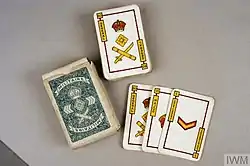Militaire
Militaire was a bespoke card game of the Rummy family for three or four players in which the playing cards depicted badges of rank of the British Army. According to the Imperial War Museum it dates to the First World War,[1] but other sources suggest it was made in the 1940s and 1950s.[2][lower-alpha 1] It came in two sizes: a standard size in an ordinary box[1] and a pocket sized version in a cardboard wallet.[2] The game is no longer manufactured.

Description
The standard game of Militaire was played with a 54-card pack comprising cards each portraying a rank badge of the British Army and a card value in points. There were 4 cards each of all the officer ranks - General (60 points), Brigadier (50), Colonel (45), Lieutenant Colonel (40), Major (35), Captain (30), Lieutenant (25) and 2nd Lieutenant (20) - and 7 cards each of the Other Ranks: Sergeant (15), Corporal (10) and Lance Corporal (5).[lower-alpha 2] In addition, there was a single card depicting the rank of Sergeant Major (5 – 60 points) which acted as a wild card or 'master card'.[1]
The pocket version of Militaire only had 40 cards: 3 of each officer rank, 5 of each other rank and 1 sergeant major wild card. The rules were the same, except that sets of 4 were only possible with the cards of the other ranks. The patience-sized cards measure 70 x 45 mm, whereas the standard cards measure 85 x 56 mm.[2]
Rules
The game was designed for three or four players; two packs were to be used if there were five or more. Deal and play were clockwise. Players cut for first dealer and then 7 cards were dealt to each player. The remainder were stacked face down in the middle of the table and the top card turned and placed beside the stock to start the discard pile.[3]
The aim was to form sets of 3 or 4 cards of the same rank or runs of at least 3 cards in rank sequence.[3]
Eldest hand began by drawing the upcard or the top card of the stock and then discarding a card to the discard pile. On completing a valid set or run, a player could meld it to the table, face up, and score points based on the card values. The first player to expose a complete hand of 2 sets or a run and a set or a run of 6-7 cards won and scored the following bonus points in addition to his card points:[3]
- Set of 3 - 30 points
- Set of 4 - 40 points
- Run of 3 - 10 points
- Run of 4 - 20 points
- Run of 6 - 50 points
- Run of 7 - 100 points
If the seventh card was unused, the holder incurred penalty points to its value. Other players only scored the value of sets or runs they meld to the table.[3] Scores were kept on a cribbage-style scoring board.[4]
Players could play an agreed number of deals, known as a "rubber".[3]
Variant
The rules described a variant played for stakes by four or more players in which a discarded card not immediately picked up by the following player could be bid for by the remainder and exchanged for any hand card; the winning bidder paying the amount of the bid to the pool which was taken by the winner of the rubber.[3]
Footnotes
- It may be that the smaller version was made later, since the sources that date the cards to the 1940s and 1950s relate to that version only.
- Card values in points are given in brackets after the rank.
References
- Card Game: Militaire Army Card Game at iwm.org.uk. Retrieved 13 Sep 2020.
- Militaire Army Card Game Vintage Card Game at worthpoint.com. Retrieved 13 September 2020.
- Rule set accompanying the Militaire card game.
- Militaire card game mystery solved by readers at yorkpress.co.uk. Retrieved 13 September 2020.